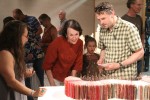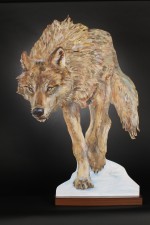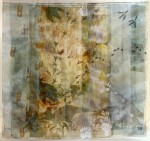This August saw the culmination of Bonanza Creek (BNZ) Long Term Ecological Research (LTER)’s newest effort to foster collaborations between the arts, humanities, and ecological sciences, with a visual and literary art exhibit entitled Trophic Cascades.
Ten competitively selected literary and visual artists were encouraged to create original work that expressed essential ideas about the complex webs of interdependence among animals (including humans), plants, and ecosystems, and the cascading effects of predator removal. By linking scientific concepts to the arts and humanities, the participants of Trophic Cascades hope to foster new social and ecological dialogues.
During the summer of 2012, artists and scientists participated in a series of field trips to learn about, observe, and discuss predator-prey-ecosystem interactions in interior Alaska. Participating artists spent three days in Denali National Park and Preserve and one day at Bonanza Creek, where they went into the field with local scientists, including experts on wolves, lynx, snowshoe hares, predatory birds and boreal forest ecosystem ecology. Participating BNZ scientists included Roger Ruess, Knut Kielland, Jamie Hollingsworth, Teresa Hollingsworth, and Mary Beth Leigh.
Postdoctoral researcher Lissy Goralnik (Andrews Forest LTER) attended the opening of the Trophic Cascades exhibit and interviewed participating artists and scientists for her work on arts and humanities inquiry emerging across the LTER network. This work is supported by an LTER Network Office Cross-site Synthesis grant to Principal Investigator (PI) Michael Nelson (AND) and Co-PIs Fred Swanson (AND) and Mary Beth Leigh (BNZ).
Trophic Cascades events included a month long visual art and literary exhibit, and an evening of literary readings and Alaska Native storytelling at the Bear Gallery in Fairbanks, a free public gallery operated by the Fairbanks Arts Association. A record 1,820 visitors viewed the exhibit from August 2-21, 2013, exceeding the attendance of all four previous BNZ arts and humanities events–all part of the program, In a Time of Change–combined. Audience perception data was collected to document observers’ experiences with the exhibit and attitudes about predators to better understand the impacts on the public of art, humanities, and science collaborations.
In a Time of Change is a BNZ-sponsored program encouraging visual, literary and performing artists to integrate artistic and scientific insights in creative, attractive, and accessible styles. Founded in 2008 by BNZ in partnership with Fairbanks citizens, In a Time of Change recognizes that art and science collaborations can engage people at the intellectual, intuitive and emotional levels, and can strengthen humans’ understanding of and appreciation for the environments and ecosystems in which they live. Trophic Cascades is the fifth In a Time of Change project.
The project was curated by Ariel Thomasson and Karin Franzen and produced and directed by Mary Beth Leigh, a BNZ microbial ecologist. Funding and in-kind support was provided by BNZ, the National Science Foundation, Denali National Park and Preserve, the Murie Science and Learning Center, Alaska Geographic, the Fairbanks Arts Association, the University of Alaska Fairbanks, and UAF’s Institute of Arctic Biology.
For more information, visit the Trophic Cascades website at https://sites.google.com/a/alaska.edu/itoc-trophic-cascades/

 Enlarge this image
Enlarge this image


